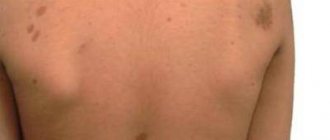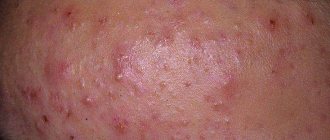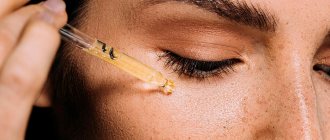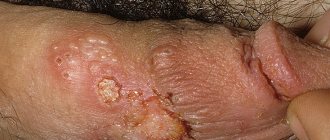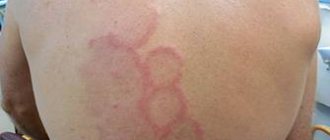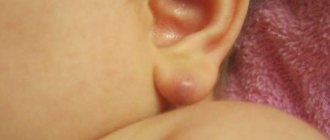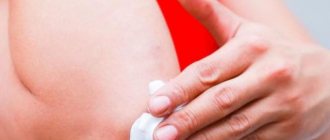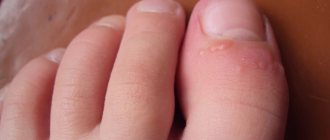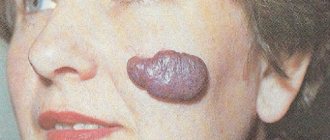- Published by: Laima Jansons
Pimples most often appear on the inner surface of the cheeks, tongue, upper palate, and on the back of the lips. This may be the result of an infection, mechanical trauma to the mucous membrane - a burn or biting, an allergic reaction, the result of irritation with various substances, drinking alcohol or smoking tobacco.
Photo 1: In children, acne in the mouth is usually of infectious origin, especially if the child’s immunity is weakened. Source: flickr (Annie Lenine).
Why do acne appear in the mouth in adults and children?
There are many reasons that cause pimples in the mouth in adults and children. A doctor will help you understand each specific situation.
- Wen. This white pimple in the mouth is a benign formation. Treatment is prescribed according to the dentist's recommendations. The wen does not cause discomfort and is not dangerous if its size is constant. But if it increases, it is necessary to take urgent measures - it could be a cyst, which poses a significant health hazard.
- A red pimple on the gum is an inflammation that has developed as a result of minor damage. Often these are purulent acne. They can be painful, but respond well to treatment if started on time. This type of rash should be treated by rinsing the mouth with antibiotics and antiseptics.
- Infections. In addition to allergies, white pimples in the mouth can signal an infection in the body. For example, measles or chicken pox can manifest themselves this way. They can be distinguished by an increase in body temperature and other signs characteristic of these diseases. Previously, it was believed that these diseases were exclusively children's diseases, but cases are increasingly being recorded in which adults also suffer from them. Pimples do not require separate treatment; it is enough to use antiseptics and sedatives.
- An abscess on the gum. A purulent pimple that appears on the surface of the gums is a consequence of insufficient oral care. You cannot take any measures on your own if it appears - you can inadvertently damage the pimple and introduce an infection into the wound.
- Herpes. A transparent pimple in the mouth occurs in children. It interferes with eating, persists for about a week, then dries up and falls off. Herpes occurs when the immune system is weakened and does not require any treatment, but you need to be extremely careful not to damage the pimple - otherwise the infection may spread.
- Stomatitis. Stomatitis is one of the main causes of pimples in the mouth. A pimple may appear in your mouth on the roof of your mouth, tongue, inner cheek or lip. Stomatitis is accompanied by swelling and inflammation, and people of any age are susceptible to it. This disease can be caused by fungi, viruses, and bacteria; the means of therapy are selected in each case separately.
- Glossitis. A red, bloody pimple in the mouth, caused by poor diet, alcohol abuse, or an allergic reaction, may indicate that the patient has glossitis. Pimples with this disease are small and extremely painful, if not treated on time - they can become crusty. Treatment is prescribed by a doctor.
- Syphilis. White pimples in the mouth of an adult, painless, may be one of the symptoms of syphilis. The rashes can be quite varied and localized in different parts of the oral cavity, so if you suspect secondary syphilis, you should definitely consult a doctor for an accurate diagnosis - it is quite difficult to recognize this disease on your own.
- Inflammation of the tooth root. Due to inflammation of the tooth root, white or yellow pimples appear on the gums. In this case, treatment is necessary specifically for the teeth, since an advanced inflammatory process can lead to extremely negative consequences, including blood poisoning.
- Thrush. A white pimple on the palate of a child, with plaque, bleeding, may signal the occurrence of thrush. The disease greatly interferes with eating, but is not dangerous. It is treated with a solution of soda and anti-fungal gels. To prevent the occurrence of candidiasis, it is necessary to promptly remove food debris from the mouth of infants and teach the child to breathe through the nose.
- Dysbacteriosis. A bloody pimple in the baby’s mouth, ulcers on the tongue and the inner surface of the cheeks often indicate incorrectly selected baby food, due to which the child has developed disturbances in the intestinal microflora - in other words, dysbiosis. In this case, it is necessary to change the feeding formula, and it is best to breastfeed the baby.
- Allergy. A white, watery pimple in the mouth is a sign of an allergic reaction and can appear in both children and adults. In this case, the patient experiences a burning sensation and a change in taste sensations. Treatment: elimination of the allergen as quickly as possible - changing diet, household chemicals. If it is difficult to determine the substance that caused the allergy, you should consult a doctor for a more accurate diagnosis.
We suggest you read How to get rid of bad breath
Stomatitis is a common initiator of the problem
Long-term inflammation of the oral mucosa is called stomatitis, which, with prolonged exposure, leads to the appearance of erosive areas. They are the ones that cause acne and sometimes blisters. Small white superficial lesions are called aphthae, which form during infection with infectious diseases (influenza, foot and mouth disease), as well as immediately after getting rid of them. The lesions disappear without a trace after 5–7 days.
Reasons for the development of aphthae due to stomatitis:
- purulent sore throat,
- chemical burn of the mucous membrane,
- poor hygiene,
- smoking,
- spicy food.
Disturbances in the functioning of the digestive tract (especially in the presence of gastritis caused by the proliferation of the opportunistic microorganism Helicobacter pylori), distortion of metabolic processes and the functioning of the cardiac system also create conditions for the formation of point inflammations. However, more often the culprits in the development of damaged mucosa are foreign agents that invade the body.
- Bacterial. Streptococci and staphylococci live in the body in small quantities, but when immunity declines, their concentration increases. The resulting imbalance harms the epithelium.
- Viral. Herpes stomatitis is a common type of lesion caused by the virus of the same name. External manifestation - bubbles with cloudy contents. A papule on the lip caused by herpes begins to crust over after 3 days. The pathogen is transmitted by contact, through air and blood.
- Fungal. The cause of damage to the mucous membrane can be a fungus of the genus Candida, leading to the formation of papules, which quickly turn into areas of white plaque with unclear boundaries.
Regardless of the type of lesion, patient complaints are often similar: pain or discomfort when touching a pimple, decreased salivation, and a burning sensation. With stomatitis, lesions of the tongue are rarely observed.
If changes are diagnosed around the mouth and on the chin, then there is a high probability of the influence of herpes, although pathological changes are a symptom of atopic dermatitis, which rarely spreads to the oral mucosa. In men, inflammation is also diagnosed due to careless shaving (bacteria enter microcracks) or due to the use of poor-quality foam, which causes individual intolerance (allergies).
A lesion similar to a pimple forms on a bitten lip or cheek, but its presence does not indicate the presence of stomatitis.
Watery pimples - clinical picture
Pimples in the mouth appear quite rarely in adults. They are indicators of the presence of a hidden disease inside the body, which can be chronic. Initially, tiny ulcers appear on the palate or inside of the cheek, characterized by the presence of an internal depression in the soft tissue.
Watery pimple
- venereal disease (a symptom of syphilis, ureaplasmosis or HIV infection);
- herpes localized in the oral mucosa (exacerbation of the disease is observed in the autumn-spring period);
- bacterial stomatitis, affecting the soft tissues of the nasopharynx (pimples resemble ulcers that cause pain when eating, drinking, spitting);
- candidal stomatitis, characterized by pimples in the mouth of an adult, covered with a dense layer of white plaque (develops against the background of a weakening of the immune and regenerative functions of the body).
Purulent white pimples in the mouth can be indicators of diseases of the circulatory system and infection, the source of which is in the intestines. Dysbacteriosis provokes a disruption of the microflora in the oral cavity, causing an inflammatory process inside the soft tissues.
To treat a pimple on the roof of your mouth, you need to see a doctor and start strengthening your immune system by taking vitamins and normalizing the caloric content of your daily diet.
The nuances of changes in children
Small red spots cover the entire body, and are also projected in the oral area in the presence of herpangina. The disease is diagnosed in a child who has become infected with the Coxsackie virus, which leads to the maturation of papules with clear liquid. After 3 days, the blisters burst, causing ulceration. Auxiliary markers of the disease are high fever, redness of the throat, and constipation.
Other childhood diseases:
- Measles. After infection, papules form in the cheek area and disappear within 2–3 days. A white coating with a green tint is concentrated on the tongue, and purulent rashes appear in the throat area.
- Whooping cough. The rash is accompanied by the appearance of a dry cough.
- Scarlet fever. Purple spots appear on the palate and tonsils. The tongue increases in size, the papillae are clearly visible on it, but after a few days the swelling subsides.
Similar symptoms are present when infected with chickenpox, in which rashes first form on the cheek, but only on the inside. There is no spread to other parts of the body.
The sudden onset of aphthae in minors is sometimes diagnosed after a change of place of residence, excessive workload at school and the influence of any other events that cause stress.
Herpes
Cold sores (fever) are a group of small pimples in and around the mouth, including the roof of the mouth areas. The area around these bumps is often red, swollen and tender. They are caused by the herpes simplex virus. Herpes is highly contagious and easily spread from one person to another. Once they appear, these pimples break open , infectious fluid leaks out, scab They disappear on average after two weeks. They are accompanied by pyrexia or fever and swollen glands.
If the situation gets worse, see your doctor for treatment.
White pimples on the roof of the mouth photo
Clogged pores
- Acne outbreaks are a widespread problem that we all face at one time or another and try to get rid of them as quickly as possible. Most people are quite used to the appearance of pimples and acne on the chest, neck, face, shoulder and upper back. But the appearance of a pimple on The palate of the mouth is a cause of concern for most patients who come to the doctor with such a problem in themselves or their children.
- If you have not previously experienced pimples in the mouth, it may seem strange to you to know that a pimple can appear in the mouth, especially on the hard upper palate and its part. Pimples on the roof of the mouth resemble regular acne, which also appears on the face.
- At first, such inflammation begins as a minute bump that appears on the roof of the mouth and grows larger and larger over the next one or two days.
- It is usually filled with pus, and if you press on a pimple on the roof of your mouth, it will burst just like a normal one.
- The causes of acne on the roof of the mouth and body are very similar. They appear when the pores in this area become infected and clogged with a large amount of pus.
- Mouth pimples are not that common, but you may be affected by the problem, especially if your body produces excess oils. Those who are vulnerable to frequent skin acne often notice pimples appearing on the roof of their mouth when they have the flu or fever. In addition to such inflammation, acne of this form can appear on any areas and parts of the body, including the inner walls of the nose or ear.
We invite you to familiarize yourself with Scattered partial absence of teeth - TOP 15 dental problems
Correct treatment of the disease
Treatment of acne in the oral cavity directly depends on the cause of the disease. Only a specialist can identify this reason. Under no circumstances should you self-medicate, as this can lead to very serious consequences.
If acne appears due to candidiasis, then doctors, as a rule, prescribe the patient antifungal drugs, antiseptic solutions for rinsing the mouth and means to enhance immunity.
To treat herpetic stomatitis, medications that have a beneficial effect on the immune system and antiviral drugs are prescribed. For any type of stomatitis, doctors prescribe vitamin complexes to the patient. Vitamin A has a particularly beneficial effect on the patient’s condition. In addition, in order to cure stomatitis, it is necessary to carry out antiseptic treatment of the mouth.
If pimples appear due to allergies, then first of all you should get rid of the allergen. This can often be any food item, chewing gum, toothpaste or mouth freshener. Often, medications can cause an allergic reaction. In this case, the doctor must adjust the treatment and prescribe other medications.
We invite you to familiarize yourself with Caries, toothache - what to do, treatment in Moscow and the region
How to get rid of the problem?
First of all, you need to consult a doctor, especially if a purulent pimple has appeared in your mouth, which hurts and brings a lot of inconvenience. Self-medication in this case will not lead to anything good. For any type of rash, it is worth consulting a doctor so that he can determine the reason for the acne, in order to then determine the correct treatment strategy.
Treating pimples that appear on the cheeks or on the roof of the mouth depends on the disease that caused them. For example, if the causative agent is a fungus, then it is necessary to take antifungal drugs, for example, Nystatin or Fluconazole. In most cases, antiseptic mouth rinses are used to treat rashes, which are especially effective when the disease is bacterial in nature.
For herpetic stomatitis, it is necessary to use antiviral drugs, as well as take medications that will boost overall immunity, which will allow you to quickly get rid of the disease.
If the cause is an allergy, then you need to remove the allergen away and take antihistamines.
What else could it be from?
Another reason why white pimples may appear in the mouth is herpangina. This is a viral disease caused by the Coxsackie virus.
You can only get it from another person. Herpangina is one of the common infections found in children.
Characteristic symptoms are:
- increased temperature, fever;
- sore throat;
- headache;
- ulcers in the mouth, which are combined with rashes on the palms and soles of the feet.
Pimples can be very painful.
Precautions when treating acne on the palate in adults and children
- Brush your teeth as gently as possible Maintain oral hygiene daily, also use dental floss and rinses.
- Avoid Stress and Relaxation Acne flare-ups are widely associated with stress during times of intense emotional depression. Acne on the roof of the mouth can be aggravated by stressors.
- Pay attention to your diet and avoid fatty, oily foods.
- Avoid spicy or hot foods, which can further irritate acne Peppers and carbonated drinks should be avoided Fruits and vegetables such as oranges, pineapples, lemons, apples, tomatoes and strawberries can also cause acne.
- Increase your intake of vitamin B12, zinc, iron and folic acid If you need to take vitamin supplements, you should first consult your doctor or nutritionist.
- Try not to irritate the inside of your mouth. Avoid smoking and using tobacco.
Preventing painful rashes
To prevent rashes in the mouth, you should take care of your immune system. To do this, you need to periodically take vitamins, eat right, stop smoking and drinking too much alcohol, lead an active lifestyle, try to avoid stressful situations and, if possible, harden yourself.
We suggest you read What to do when a dental crown falls out or breaks
Particular attention should be paid to oral hygiene:
- brush your teeth twice a day;
- change your toothbrush every month (its bristles should be soft and not injure your gums);
- Use dental floss to remove food debris;
- rinse your mouth regularly with mouthwash;
- visit the dentist at least once every six months to prevent caries, plaque and other problems with the health of teeth and gums.
It is also recommended to exclude foods that can cause an allergic reaction from the diet, treat all diseases (especially infectious ones) in a timely manner, drink enough water, chew food thoroughly, and do not consume very hot food and drinks. For explanations on preventing the appearance of rashes and pimples on the roof of your mouth, tongue, cheeks and lips, you should contact your dentist. By following all these recommendations, you can significantly reduce the likelihood of unpleasant pimples appearing in your mouth.
Small pimples that appear in the mouth are a rather unpleasant phenomenon that occurs due to certain conditions and diseases. Small pustules may appear on the inside of the lips, on the roof of the mouth, tongue, cheeks and under the tongue. Wherever they arise, a person has a strong desire to get rid of them. And this is not surprising, because pimples can interfere with speaking and eating normally.
Preventing rash formation
To prevent papules from appearing near and inside the mouth, follow the rules of hygiene.
Recommendations:
- refuse to use someone else's lipstick;
- avoid unprotected sex;
- take vitamins in a course 2 times a year;
- brush your teeth at least 2 times a day;
- use mouthwash.
Timely treatment of infectious diseases will also prevent the appearance of rashes due to the spread of pathogenic agents throughout the body.
Pimples on the palate of a child's mouth
Poll: When did your acne appear? (Qty: 4295)
I've been suffering all my life
It's been a couple of years now
About a few months
Recently
To answer, click on the desired answer option. results
Pimples on the roof of the mouth in a baby or preschool child can also be caused by Epstein's pearly disease, which are common, benign, painless cysts that affect about 80% of babies. Also known as palatal or gingival cysts, these pimples are white or yellowish bumps found more commonly all over the roof of the mouth They can be mistakenly perceived as growing teeth, however, you can also understand that these are pimples when wearing glasses.
Epstein pearls form in the uterus when the mucous membranes become trapped during palatal formation.
These oral pimples do not require any treatment because they are harmless, painless, and usually disappear within a few weeks. If Epstein's pearls are still present after a few weeks, discuss their treatment with your doctor.
Irritation caused by food
Pimples on the roof of your mouth can be caused by irritation after eating something too hot or spicy. Pimples on the inside of your mouth can also be caused by a burning sensation caused by eating overly spicy, salty or sour foods. So make sure that the temperature of your food is normal and that the regular food you eat you consume does not cause irritation in the form of a pimple after some time. Especially in a child, hot food can cause pimples on the upper palate of the mouth.
White and red pimples on the roof of the mouth are still not a permanent form of acne; if they appear again and again, then they can be symptoms of even more severe diseases such as oral cancer or symptoms of herpes.
Inflammation of the gums as a factor in the formation of rashes
If the localization of inflammation is on the gingival part of the jaw and the papule increases over time, then there is a high probability of the presence of a lesion developing in the roots of the tooth. Recent interventions, including the installation of an implant, crown or prosthesis, provoke the inflammatory process.
The spread of caries that affects the pulp also leads to the appearance of purulent contents, which can exit through the fistula canal. Cloudy discharge from the papule indicates a dental problem that should be addressed in the clinic (canal treatment, curettage).
A pimple in the form of an abscess is a forming cyst, which is suppressed mainly with antibiotics.

